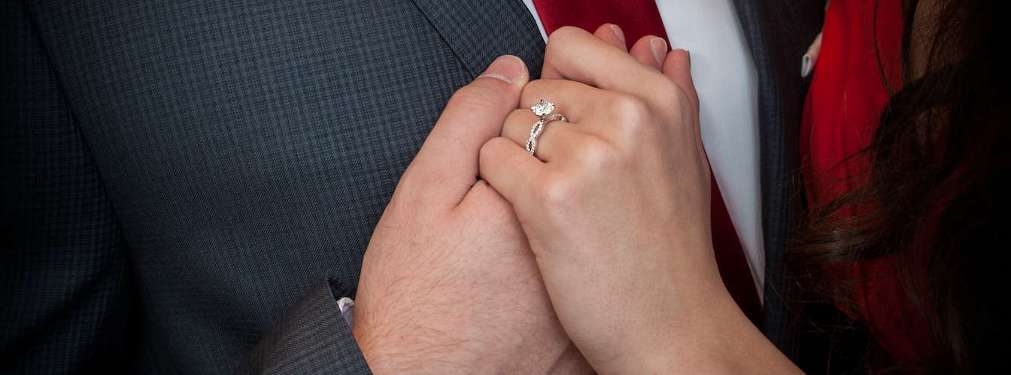
Where Can I Buy Cushion Cut Diamonds With Hearts And Arrows?
Q: I am interested in cushion cut diamonds. My girlfriend really likes this shape though she also likes hearts and arrows diamonds. I have read that women who love this shape are strong contemporary women on the outside while being equally romantic and traditionally strong in personal relationships. This describes her to a T, so I think a cushion cut with hearts and arrows would be ideal. Can you point me in the right direction? S.
A: Hi S, thanks for your message. I am very happy to let you know that this one's an easy one. I knew exactly where to look for this thanks to a relatively recent innovation by one of the world's foremost authorities on hearts and arrows diamonds.
Introducing Brian Gavin's Signature Cushion with Hearts and Arrows
Brian Gavin Diamonds' Cushion Cut With Hearts & Arrows

www.briangavindiamonds.com/diamonds/brian-gavin-signature/cushion-hearts-arrows
An Improvement on a Classic
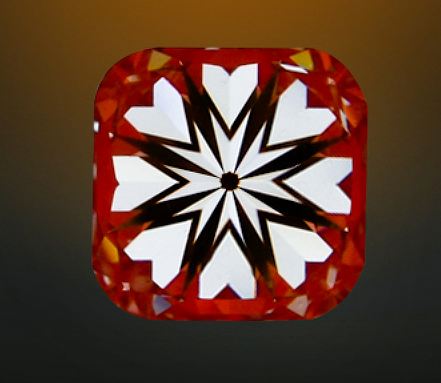
I was absolutely blown away when Brian Gavin introduced his new take on the cushion-cut diamond that has hearts and arrows patterning. You might also hear this attractive shape being called a pillow cut. Many a royal has been seen sporting this shape of diamond. The cushion cut itself is somewhat similar in shape to the Old Mine Cut diamonds. The origins of the Old Mine Cut diamonds go back to well over 100 years ago. The shape was developed over the course of time during the late 1800's and early 1900's. The shape eventually grew into the cushion cut. Cushion cut diamonds are well loved for engagement rings, but are equally suited to earrings, studs, pendants, and various styles of rings. Cushion cut diamonds have seen surges in popularity over the years. Anyway you're probably already familiar with the cushion cut diamond. What we are talking about here is a revolutionary new way to cut the cushion cut that makes it hold its own in terms of brilliance compared to the king of brilliance, the round brilliant cut.
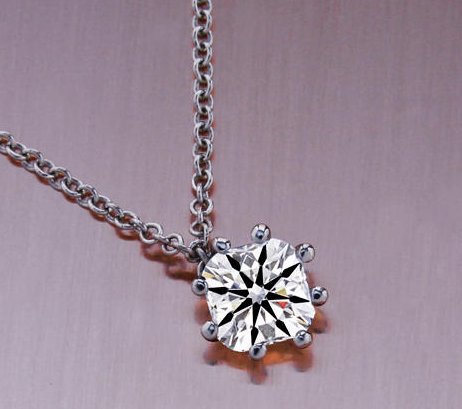
Brian Gavin Diamonds were already renown for having the highest degree of optical symmetry to be found anywhere. When they delivered a new design I was eager to check it out. It is truly a distinctive diamond design that I think truly achieves the balance needed to produce brilliance, sparkle, as well as a remarkable hearts and arrows pattern. This diamond is one of Brian Gavin's finest innovations and shows his discerning eye and practiced hand.
Greater Brilliance With This Style Of Cut
Brian Gavin's cushion cut diamonds come with an AGS certificate. They all pass the test for AGS' highest Light Performance grade being a '0'. I have often said that no other shape can compete with the round brilliant for light performance. Well this little stunner has given the round brilliant cut a run for its money. Peter Yantzer, head of the American Gem Society Laboratories, was very impressed with this Gavin design, saying "a Cushion shaped diamond with round brilliant faceting provides the highest levels of brilliance and dispersion". That is quite a statement considering the AGS is the foremost laboratory specializing in grading and Light Performance Technology for the evaluation of diamonds.
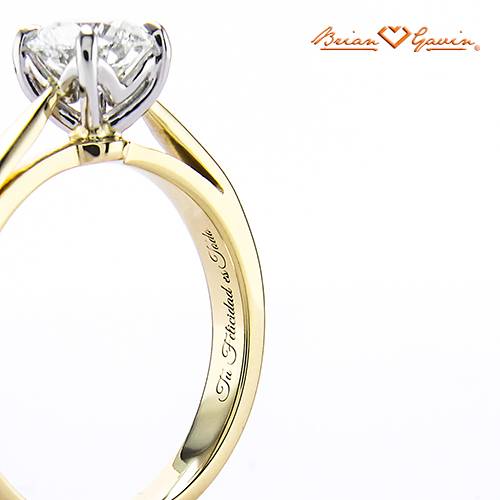
It's actually an incredible feat to produce a cushion cut diamond that is in fact more brilliant than many round stones. Round brilliants have always been considered the industry standard for brilliance. Nothing was supposed to be able to beat them. Basic physics! However the Brian Gavin Signature Cushion Cut Diamond with Hearts and Arrows has been carefully cut and precisely designed to achieve maximum brilliance and fire. This is no small feat. Diamonds are more often than not either heavy on the brilliance, or optimized for greater fire. Its the 57 finely crafted facets plus culet yielding a total of 58 perfectly cut surfaces to reflect and refract light at very precise angles that brings this balance of brilliance and fire. This cushion cut is therefore able to reproduce the stunning effect we get from round brilliant diamonds. The design's maximum sparkle factor is a result of the perfect hearts and arrows patterning. It is not a stretch to say that it far outshines other diamond cuts (shapes). This expertly cut Brian Gavin diamond taking its place among the classics.
The Secret Sauce: Master Craftsmanship + Perseverance

The way Brian Gavin has skillfully cut and crafted this stylish diamond shows a meticulous sculpting technique. He has shaped a squarish stone to feature gently rounded corners. Rounding the sides softens the diamond's general impression. You therefore get a unique and attractive romantic look.

The girdle is thin and evenly proportioned. The girdle is the outer edge where the stone's top section meets the bottom section. The top section is called the crown and bottom section is called the pavilion. The Brian Gavin Hearts and Arrows Signature Cushion diamond offers greater beauty and durability than less-carefully crafted cushion-cut stones. The problem you'll often find in poorly cut cushion cuts is that many of them have extremely thin or extremely thick girdles. Neither is great. A too-thick girdle looks like chalk line around the edge of the diamond. Not something you want. And an extremely thin girdle can be a pain when setting a diamond as can be vulnerable and prone to chipping. Not only during the setting but even in general wear. Every Brian Gavin diamond is carefully cut and designed for optimal girdle thickness. Not too thick and not too thin. Every aspect of a Brian Gavin Diamond is designed to produce the optimal combination of beauty and strength. That's Brian Gavin for you: high quality in every regard. It's this sort of thoughtful process in every detail that makes the Brian Gavin Diamonds brand what it is today.
A Whiter-Looking Stone A Result Of Ideal Proportions
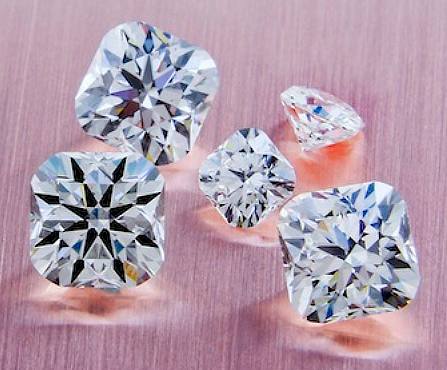 Carefully crafted to feature Ideal proportions the Brian Gavin Signature Cushion Cut Diamond with Hearts and Arrows makes even lower color-grade stones, such as J or K, appear much whiter to the eye. I have written about this on several occasions. Higher and more efficient light performance reduces the color. It's like magic, but it isn't. It's just physics. Call it physics, magic, or technical skill combined with creative artistry, Brian Gavin has managed to draw out each stone's natural beauty. Brian Gavin stones perform to their full potential. As you can probably imagine it does take time to create such precise gems. But it then becomes possible for you to enjoy a whiter-looking stone from among the more affordable price points that the lower color grades provide. “The most important characteristic is cut -- which has the greatest impact on a diamond's overall beauty.”
Carefully crafted to feature Ideal proportions the Brian Gavin Signature Cushion Cut Diamond with Hearts and Arrows makes even lower color-grade stones, such as J or K, appear much whiter to the eye. I have written about this on several occasions. Higher and more efficient light performance reduces the color. It's like magic, but it isn't. It's just physics. Call it physics, magic, or technical skill combined with creative artistry, Brian Gavin has managed to draw out each stone's natural beauty. Brian Gavin stones perform to their full potential. As you can probably imagine it does take time to create such precise gems. But it then becomes possible for you to enjoy a whiter-looking stone from among the more affordable price points that the lower color grades provide. “The most important characteristic is cut -- which has the greatest impact on a diamond's overall beauty.”
Brian Gavin
Brian Gavin's Hearts and Arrows

It's not by accident that Brian Gavin has become one of the foremost authorities on Hearts and Arrows. He is a fifth generation diamond cutter. He learned his trade living near the diamond mines of South Africa where he grew up. Over the years Brian Gavin has developed a number of original diamond designs. It was his groundbreaking work on the original hearts and arrows diamond design created by Japanese gem cutters in the 1980's got the attention of diamond lovers around the world. His original version of the hearts and arrows design was known as A Cut Above®. In 2009, he established a new standard in hearts and arrows diamond craftsmanship. At present his Cut Beyond Brilliant® Signature Hearts and Arrows round brilliant line enjoys huge demand among diamond buyers around the world who appreciate high quality workmanship.
Brian Gavin's Signature Cushion: Why It works
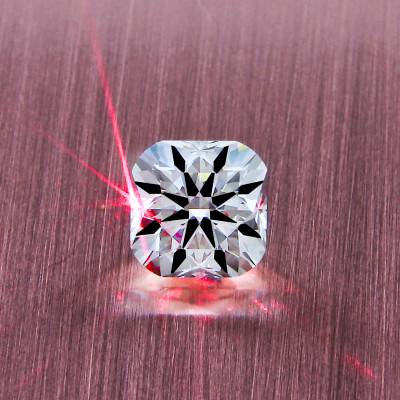 What initially inspired Brian Gavin to design this Cushion Cut Diamond with Hearts and Arrows was the challenge it posed. He set off to see if it was possible to combine the much loved cushion cut with the best of round brilliants, and still have a top performing diamond. Up to that point there were already quite a few square and cushion cut diamonds available which did exhibit patterns of hearts and arrows. The reason he didn't think they were good enough is that most of them are cut with big, thick, girdle edges. This he could see was problematic. These big girdle edges would act like open windows to the heart of the stone. What does that mean? Light leakage and unsightly girdles in general.
What initially inspired Brian Gavin to design this Cushion Cut Diamond with Hearts and Arrows was the challenge it posed. He set off to see if it was possible to combine the much loved cushion cut with the best of round brilliants, and still have a top performing diamond. Up to that point there were already quite a few square and cushion cut diamonds available which did exhibit patterns of hearts and arrows. The reason he didn't think they were good enough is that most of them are cut with big, thick, girdle edges. This he could see was problematic. These big girdle edges would act like open windows to the heart of the stone. What does that mean? Light leakage and unsightly girdles in general.
Brian took up the challenge. His dream was to create a diamond that is more beautiful than the cushion cut diamonds that were available at the time. It was even more challenging than he anticipated, and took a couple more years than he thought it would.
The goal he'd set was to design a cushion cut diamond with an improved girdle edge. He knew it could be thinner, and more consistent, than some of the other cushion cut diamond designs around. An ideal girdle means maximum spread. Too thick and you have lost some of the potential surface area, losing apparent size. Too thin , and well you already know: vulnerable edges. What he didn't want though was to neglect the light performance. Brian Gavin Signature Diamonds are all produced to a cut quality that consistently warrant an overall cut grade of AGS Ideal 0, on the Platinum Light Performance grading standard. This one would also have to keep up to the same standard as the other Brian Gavin Signature cuts.

While the first goal was to improve the girdle of cushion cut diamonds for the above mentioned reasons Brian keen to see if he could have the new design exhibit a pattern of hearts and arrows. Brian knew that the pattern would not be as perfect, or symmetrical as the Hearts and Arrows that are exhibited in the Signature Round series. The different geometry of the circumference and perimeter would mean that it would be challenging.
A number of attempts, sketches and computer drawings later Brian began the process of cutting the diamonds which were to be the prototypes. He finally reached the conclusion that in order to achieve his goal he would have to make a ground breaking adjustment to the diamond facet design.
In order to achieve the desired results he decided that the pavilion main facets would be rotated. In a round brilliant cut diamond the pavilion main facets are in most standard designs positioned in the twelve and six o'clock positions as shown in Diagram #1 whereas in Diagram #2 they are rotated. These diagrams show the design of a round brilliant cut diamond. Move on to Diagram #3 and you can see how the main facets of the Brian Gavin Signature Cushion pavilion are rearranged. This concept of rotating the pavilion main facets was the key to unlocking the hearts and arrows effect in a this cushion cut shape.
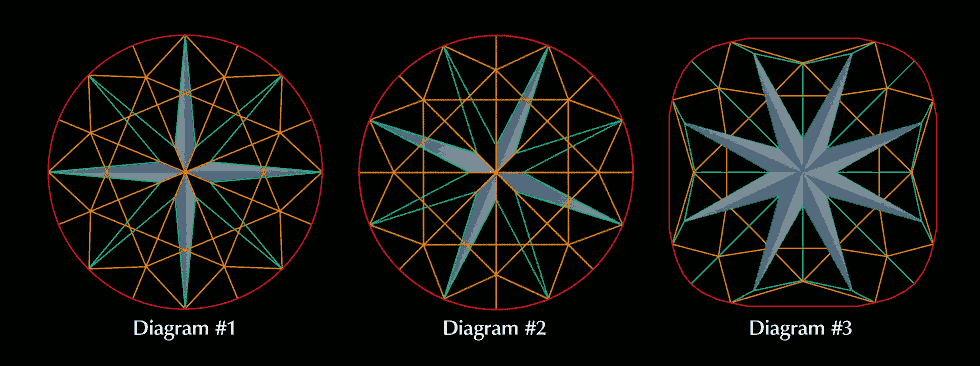
The result of all this is a diamond that is more durable due to a more consistent girdle without having it be too thick or thin. This factor was a key to optimizing the diamond. The new design produces better light return and improved visual performance. Visual performance is just a more technical sounding term which is basically just a fancy term for the "sparkle factor" of the diamond. In terms of brilliance, dispersion and scintillation this was an incredible feat.
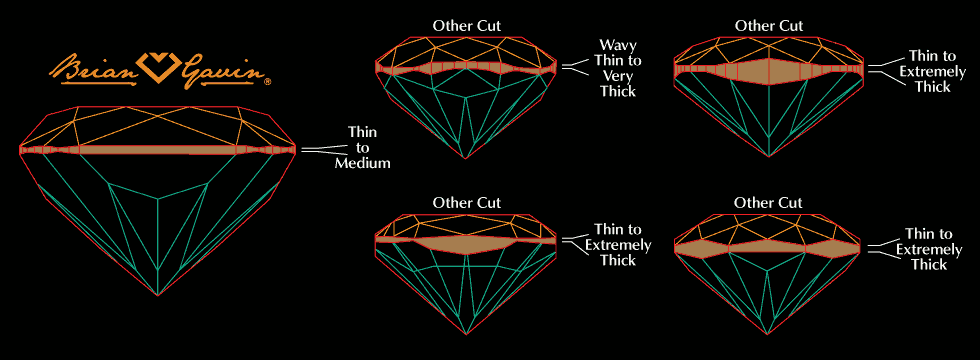
Here you can see a diagram that indicates how the girdle edge of Brian Gavin Signature Cushion Cut Diamond looks in comparison to the girdle edge of several popular variations of square cushion cut diamonds.
Even though it would have been possible to produce a pattern of hearts and arrows with an extremely thick girdle edge, one of the important goals of the redesign was to improve the girdle size. It not only produces better spread but it also produces a more attractive diamond.
It's quite a challenge to produce these diamonds. They are not perfectly symmetrical like what you get with a round brilliant cut diamond. In round brilliants, when cut to ideal proportions as are all Brian Gavin Signature round diamonds every facet section is equal in distribution. The spacing across each section of the diamond is also made to be identical. Brian had to accept the fact that the production parameters for his new line of Signature Cushion Cut diamonds would be a bit broader than the qualifying criteria for Brian Gavin Signature round brilliant cut diamonds.
You just have to look at the facet design of the diamond featured below on the right, and then compare it to the facet structure of the round brilliant cut diamond shown on the left to see what I mean. It obviously takes an incredible level of skill and patience to hand-cut these diamonds to achieve this level of accuracy.
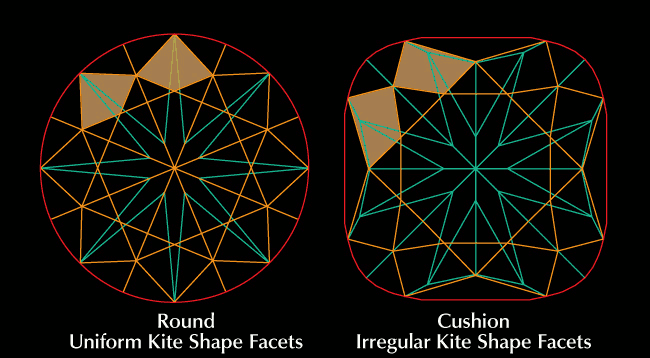
There is a distinct difference between round brilliants and cushion cut diamonds. I know that's an obvious statement, but you can see what I mean here. The outline of a regular round brilliant cut diamond, shown on the left side of the above diagram depicts the bezel main facets. You can see that they are kite shaped. Now the outline of the cushion cut diamond, shown on the right side of the diagram, is more pillow shaped. This changes the fundamental shape of the traditional kite facet. As they can no longer be kite shaped the only option is a rhomboid. Once the pavilion facets are aligned the tip of the arrow no longer meets the point of the kite facet. This causes a slightly different version to the traditional patterning of hearts and arrows that we would see in an ideal round brilliant cut diamond.
The AGSL research on the "life" of the diamond, also called the sparkle factor, is calculated using computer modeling. It measures and describes the essential elements of what is captured by the human eye. Brian Gavin Diamonds consulted the research conducted by the AGSL in great depth. Thus they we able to optimize the three dimensional facet structure of a diamond by using the AGSL research. Both the vertical and horizontal alignment of the facets per section were therefore placed in such a way to create a greater number of virtual facets. This has the very desirable result of producing larger flashes of light. This in turn, increases the "life" of the diamond, in other words the sparkle factor of the diamond.
The development of this diamond would not have been possible without cooperation of the AGSL. It was in the lab that all the modeling was done which was necessary to determine the exact parameters required. After all, the goal was to achieve an AGS Ideal (0) Light Performance grade.
The result of it all was that Brian triumphed in producing an ideal cut version of a cushion cut diamond. The new design is built on the foundation of the science of light performance. The superior light return, and "life" of a round brilliant cut diamond was already understood and used in order to produce the Brian Gavin's Signature Cushion with Hearts and Arrows.
Measurements used in a Brian Gavin's Signature Cushion with Hearts and Arrows
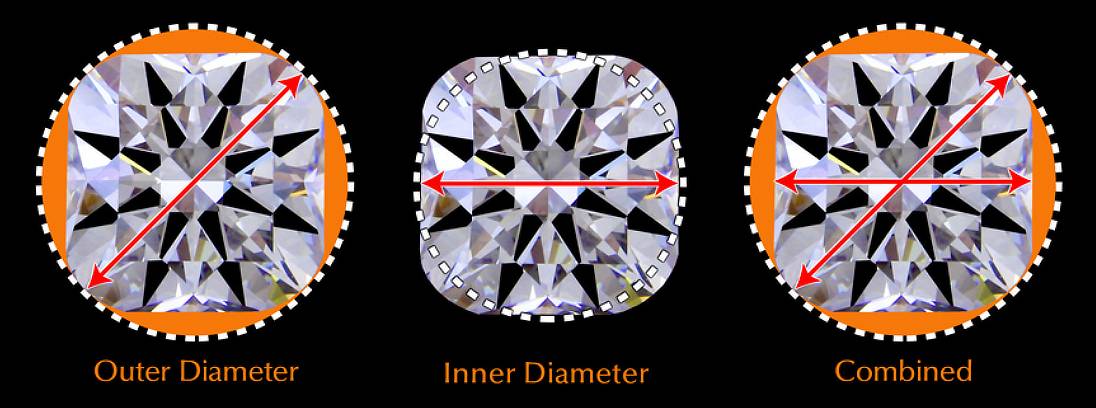
Understanding this one can save you a bit of confusion later when looking at the measurements on the diamond grading report.
The Brian Gavin Signature Cushion Cut Diamond is measured a little differently to the way traditional square cut diamonds are measured. The reason being that the rounded corners affect the diameter of the diamond. Square brilliant cut diamonds are for the most part measured from edge-to-edge one way and then perpendicular to the first measurement. Just imagine North to South for the first measurement and then East to West for the second. The Brian Gavin's Signature Cushion with Hearts and Arrows are measured diagonally longest tip to tip and then edge to edge. Whichever measurement gives the longest tip-to-tip measurement is written first on the grading report. The second measurement is the shorter of the two. This proves to be an excellent way to measure Brian Gavin's Signature Cushion with Hearts and Arrows. If the diamond were measured differently part of it would be missed: the surface area of the corner sections.
The picture above give you an idea as to what I mean. It shows you how this diamond is measured. The dotted white demarcation shows what a round brilliant cut diamond would look like if it had the same diameter. These measurements were based on 1.662 carat, F-color, VVS-2 clarity, Brian Gavin Signature Cushion Cut Diamond. It measures 7.91 x 6.62 x 4.83 millimeters as per the AGSL grading report. The first measurement of 7.91 mm is the result of measuring the diamond across the longest corner-to-corner measurement. The second measurement (6.62 mm) is gotten by measuring across the diamond. That is the shortest distance anywhere, edge to edge on the diamond. The third measurement, not shown, is the 4.83 mm the lab got by measuring the distance from the table facet to the culet. The diagram to the right shows the combined tip-to-tip and edge-to-edge measurements. The right diagram shows how Brian Gavin Signature Cushion Cut Diamonds are measured.
If the (AGSL) had chosen to measure the Brian Gavin Signature Cushion Cut Diamond using the edge-to-edge method it would not have provided a true idea of the diamond's measurements. The method used to measure many other square shapes would have neglected parts of surface area of the diamond. The outer boundary of the diamond would not have been accurately represented. This is why the AGSL measures the diamond from tip-to-tip, and from edge-to-edge. This takes the full surface area of the diamond into account. You can see that this is a much better way to determine the diameter of this shape of diamond. If you are not aware that this is the way the Brian Gavin Signature Cushion Cut Diamonds is measured by AGSL it might look like the diamond does not have a 1:1 ratio. So understandably this can be a little confusing at first glance. The difference in the first two number shown in the measurement of a Brian Gavin Signature Cushion Cut Diamond makes it look like the diamonds are rectangular. For example, the measurements of the 1.662 carat, F-color, VVS-2 clarity, Brian Gavin Signature Cushion Cut Diamond used in this article, measures 7.91mm x 6.62mm x 4.83mm. That makes it look like it has a length to width ratio of 1.00:1.19. That is if you don't know that the measurements aren't perpendicular but one is diagonal. If these were the measurements taken from a traditional fancy shape diamond you would think this diamond is slightly rectangular. So now you know. The diamonds will not have a l/w ratio given.
As you can see in the diamonds and the superimposed diagrams in the above picture measuring the diamond from edge to edge would result in an inaccurate representation of the surface area of the diamond. Measuring this diamond can only be done accurately by including the measurement taken from across the body of the diamond. So tip-to-tip and across the diamond from edge-to-edge. The AGSL has been using this method of measuring specific diamond shapes since 2001. The Brian Gavin Signature Cushion Cut Diamond is not the only diamond cut that has a cut-specific way of being measured. Luckily for you, you are now clued in on how it's done.
Of course you are probably wondering how a Brian Gavin Signature Cushion Cut Diamond faces up in comparison a Brian Gavin Signature Round Brilliant Cut Diamond.
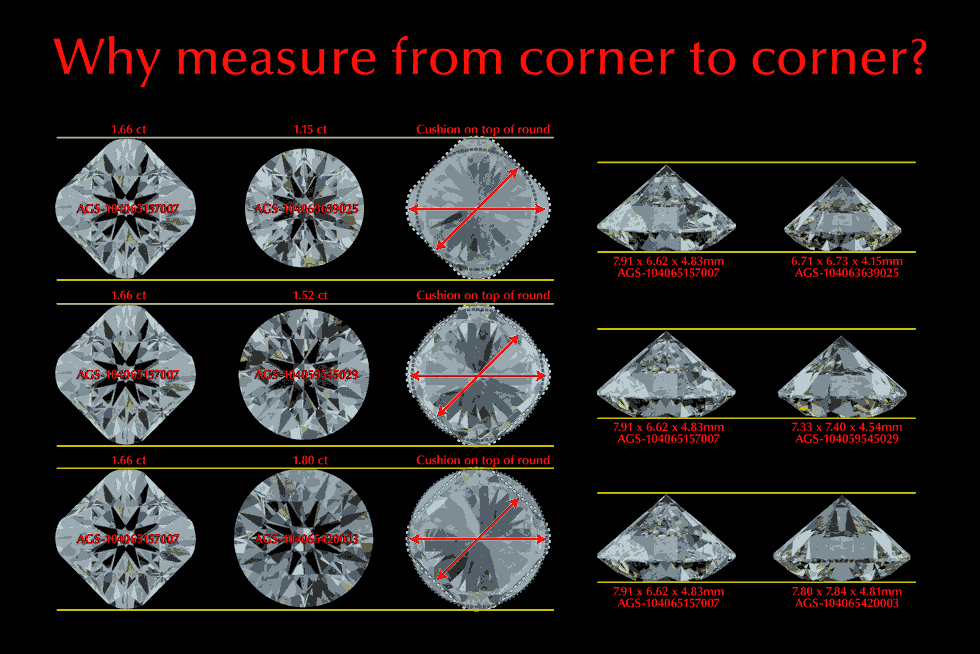
First Row:
I'll stick with the diamonds we have been using in this article. The Brian Gavin Signature Cushion Cut Diamond is a 1.662 carat, F-color, VVS-2 clarity. The first row of images over on the left side of this graphic, shows the 1.662 carat, photographed side-by-side a 1.15 carat, Brian Gavin Signature Round, which has an average outside diameter of 6.72 mm. The third picture in the row, consists of the cushion cut diamond laid over the 1.15 carat round, and the outside diameter of the round is highlighted in gray, you can see that the cushion cut diamond has an outside diameter which appears larger than that of the 1.15 carat round.
If you look at the horizontal yellow lines which frame the top and bottom edges of the diamonds, you can plainly see that the span of the cushion cut diamond as viewed from tip-to-tip appears larger than the span of the round brilliant cut diamond, because the edges of the round diamond are not touching the yellow lines. And if you look at the second row of images featured to the right side of the graphic, you can see that the side profile of the 1.662 carat cushion cut diamond is also clearly larger, both in terms of width and height.
Second Row Analysis:
Next we can compare the 1.662 carat cushion cut diamond to a Brian Gavin Signature Round weighing 1.52 carats. The latter has an average outside diameter of 7.365 mm. As you can see, the span of the cushion cut diamond, as seen from tip-to-tip, still appears larger than that of the 1.52 carat round, even if only slightly so. If we overlay the 1.662 carat cushion over the 1.52 carat round, the outer edges of the corners of the cushion cut can be seen to exceed the outside diameter of the round brilliant shown in the gray outline.
So as you can clearly see, the diamonds pictured in the second row to the right, clearly indicate that the cushion cut diamond appears deeper and wider than the round brilliant cut diamond.
Third Row Analysis:
Finally, we can compare the 1.662 carat cushion cut diamond with a 1.80 carat Brian Gavin Signature Round. This one has an average outside diameter of 7.82 mm. As is apparent from the third row of diamond on the left side of the above graphic, the spread across the diamonds appears to be nearly the same, the tip-to-tip view of the diamond faces up virtually the same height as the round, and is essentially even to the yellow horizontal lines which frame the diamonds at the top and bottom.
And if you compare the two diamonds, pictured in the second column of the graphic to the right side, you'll see that they appear virtually equal in terms of height and width.
So yes you can get cushion cut diamonds with hearts and arrows. And now you know how they are measured and how they face up.
If the AGSL were to measure the Brian Gavin Signature Cushion Cut Diamond from edge-to-edge, like a traditional square cut diamond with pointed corners, the outside diameter measurements would result not accurately represent the surface area of the diamond. Thus the AGSL measures this diamond from tip-to-tip, and edge-to-edge in accordance with standard gemological practices which the laboratory has had in effect since 2001 and used for many fancy cut diamonds.